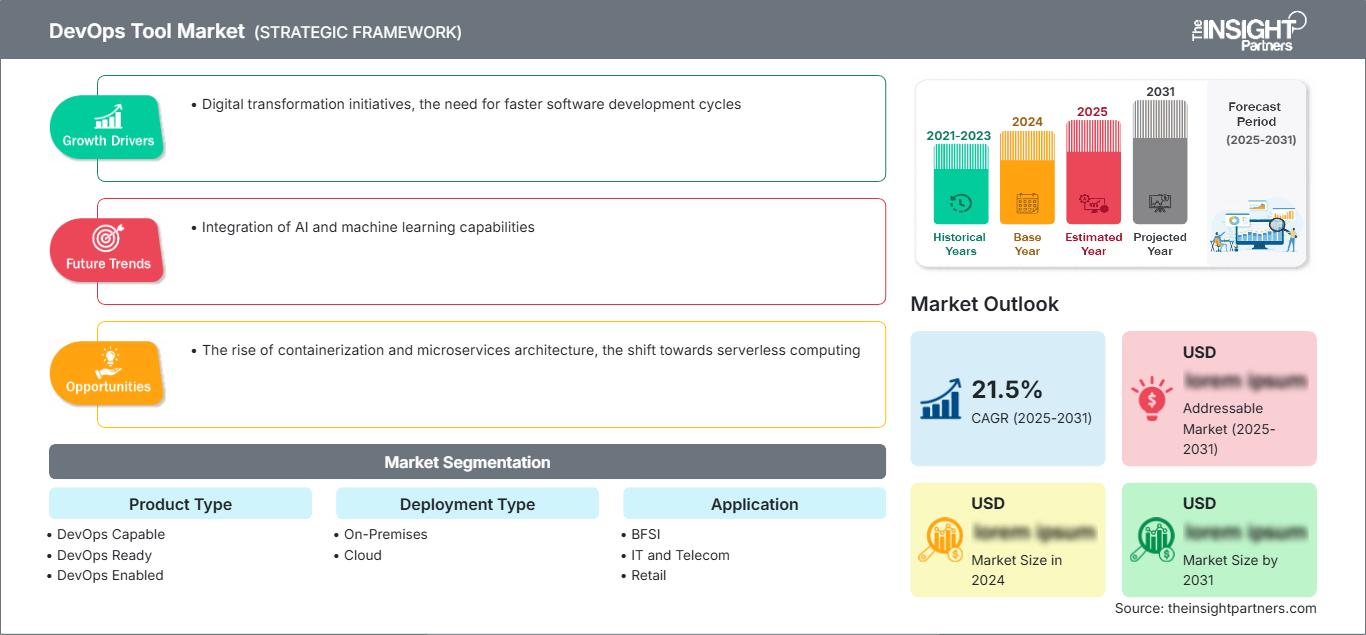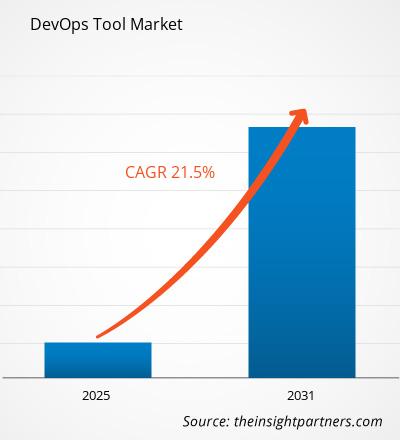Der Markt für DevOps-Tools wird zwischen 2023 und 2031 voraussichtlich eine durchschnittliche jährliche Wachstumsrate (CAGR) von 21,5 % verzeichnen. Der Aufstieg der Containerisierung und der Microservices-Architektur sowie die Umstellung auf serverloses Computing bleiben voraussichtlich die wichtigsten Trends auf dem Markt.
Marktanalyse für DevOps-Tools
- Da DevOps-Tools darauf ausgelegt sind, die Softwareentwicklung und -bereitstellung zu beschleunigen, nimmt ihre Akzeptanz zu, und führende Unternehmen aller Branchen investieren massiv in DevOps-Tools.
- Großunternehmen sind die klaren Spitzenreiter, da viele bereits durchgängige DevOps-Toolchains eingeführt haben.
- Mittelständische Unternehmen holen schnell auf. Die führenden Tools reichen von Versionskontrollsystemen über CI/CD-Plattformen (Continuous Integration/Continuous Deployment) und Containerisierungstechnologien bis hin zu Überwachungstools.
- Auch Cloud-native DevOps-Tools sind auf dem Vormarsch, da der allgemeine Trend zum Cloud-Computing anhält. Die Akzeptanz ist unterschiedlich. Manche Organisationen sind noch neu bei DevOps oder hinken Aspekten des kulturellen Wandels oder der Integration hinterher.
Marktübersicht für DevOps-Tools
- Der DevOps-Markt wächst stark dank zunehmender Digitalisierungsinitiativen zur Transformation von Unternehmen und zur Bewältigung der Herausforderungen der ständigen technologischen Weiterentwicklung sowie der Notwendigkeit, Software schnell und einfach bereitzustellen.
- Zahlreiche große Technologieunternehmen und Startups drängen in den Markt und bieten eine Reihe von Tools und Plattformen für Automatisierung, Zusammenarbeit und kontinuierliche Integration/Bereitstellung. Nordamerika ist führend bei der Akzeptanz, aber der asiatisch-pazifische Raum folgt mit schnellem Wachstum. Die Nachfrage nach Cloud-Plattformen steigt. Der Markt war mit Herausforderungen hinsichtlich Qualifikationslücken und organisatorischem Widerstand bei der Einführung von DevOps konfrontiert, aber die Transformation wird noch lange dauern.
Passen Sie diesen Bericht Ihren Anforderungen an
Sie erhalten kostenlos Anpassungen an jedem Bericht, einschließlich Teilen dieses Berichts oder einer Analyse auf Länderebene, eines Excel-Datenpakets sowie tolle Angebote und Rabatte für Start-ups und Universitäten.
DevOps-Tool-Markt: Strategische Einblicke

- Holen Sie sich die wichtigsten Markttrends aus diesem Bericht.Dieses KOSTENLOSE Beispiel umfasst Datenanalysen, die von Markttrends bis hin zu Schätzungen und Prognosen reichen.
Sie erhalten kostenlos Anpassungen an jedem Bericht, einschließlich Teilen dieses Berichts oder einer Analyse auf Länderebene, eines Excel-Datenpakets sowie tolle Angebote und Rabatte für Start-ups und Universitäten.
DevOps-Tool-Markt: Strategische Einblicke

- Holen Sie sich die wichtigsten Markttrends aus diesem Bericht.Dieses KOSTENLOSE Beispiel umfasst Datenanalysen, die von Markttrends bis hin zu Schätzungen und Prognosen reichen.
Treiber und Chancen des DevOps-Tool-Marktes
Bedarf an schnelleren Softwareentwicklungszyklen zur Förderung des Marktes
- Ein wichtiger Treiber des DevOps-Tool-Marktes ist die Forderung nach schnelleren Softwareentwicklungszyklen in einem Umfeld, in dem sich digitale Systeme schnell verändern. Diese kritischen Systeme sollen die Wettbewerbsfähigkeit steigern und neue Dienste und Produkte auf den Markt bringen, die die Kundennachfrage und die neuen, durch die Technologie geschaffenen Möglichkeiten erfüllen.
- Dieser Geschwindigkeitsbedarf ergibt sich aus dem Wunsch, schnell und reaktionsfähig auf sich ändernde Markt-, Kunden- und technische Anforderungen zu reagieren. DevOps-Tools können die Softwareentwicklung beschleunigen, indem sie Teile des Softwareentwicklungslebenszyklus automatisieren und so die sogenannte kontinuierliche Integration und kontinuierliche Bereitstellung (CI/CD) erleichtern.
- Durch Automatisierung, Vereinfachung und Optimierung von Prozessen sowie die Reduzierung manueller Fehler ermöglichen DevOps-Tools Unternehmen eine schnellere Softwareentwicklung und Bereitstellung stabilerer Softwaresysteme. Dadurch werden Unternehmen agiler, können schneller iterieren, ihre Produkte und Dienste schneller auf den Markt bringen und ihre Wettbewerbsfähigkeit steigern, was wiederum zu mehr Umsatz und mehr Geschäft führt. Daher trägt die Nachfrage nach einem schnelleren Softwareentwicklungslebenszyklus zum Wachstum und zur Innovation des DevOps-Tool-Marktes bei.
Integration von KI- und Machine-Learning-Funktionen
- Die Integration von KI- und Machine-Learning-Funktionen ermöglicht es DevOps-Tool-Anbietern, die in diesen Technologien eingebetteten Automatisierungs-, Entscheidungsfindungs- und Vorhersagefunktionen zu nutzen.
- Tools mit KI- und ML-Funktionen können viele komplexe Aufgaben automatisieren, Systemausfälle vorhersagen, die Ressourcennutzung identifizieren und maximieren, die Qualität und Effektivität von Sicherheitsleitplanken verbessern und intelligente Warnungen und Einblicke in die nächsten Schritte liefern.
- DevOps-Tools können anspruchsvollere Funktionen wie vorausschauende Wartung, intelligentere Tests und bessere Kapazitätsplanung bieten. Eine solche Integration steigert nicht nur die Effizienz und Effektivität von DevOps-Prozessen, sondern hilft den Anbietern auch dabei, sich durch Differenzierung von den zahlreichen alternativen Tool-Anbietern abzuheben.
Segmentierungsanalyse des DevOps-Tool-Marktberichts
Wichtige Segmente, die zur Ableitung der DevOps-Tool-Marktanalyse beigetragen haben, sind Produkttyp, Bereitstellungstyp und Anwendung.
- Basierend auf dem Produkttyp ist der DevOps-Tool-Markt in DevOps-fähig, DevOps-bereit und DevOps-fähig unterteilt.
- Basierend auf dem Bereitstellungstyp ist der DevOps-Tool-Markt in vor Ort und in der Cloud unterteilt. BFSI, IT und Telekommunikation, Einzelhandel, Sonstige
- Basierend auf der Anwendung ist der Markt für DevOps-Tools in BFSI, IT und Telekommunikation, Einzelhandel und Sonstige unterteilt.
Marktanteilsanalyse für DevOps-Tools nach Geografie
- Der Marktbericht für DevOps-Tools umfasst eine detaillierte Analyse von fünf großen geografischen Regionen, einschließlich der aktuellen und historischen Marktgröße und Prognosen für 2021 bis 2031, und deckt Nordamerika, Europa, den asiatisch-pazifischen Raum (APAC), den Nahen Osten und Afrika (MEA) sowie Süd- und Mittelamerika ab.
- Jede Region ist weiter in die jeweiligen Länder unterteilt. Dieser Bericht bietet Analysen und Prognosen für über 18 Länder und deckt die Marktdynamik von DevOps-Tools ab, wie z. B. Treiber, Trends und Chancen, die die Märkte auf regionaler Ebene beeinflussen.
- Darüber hinaus umfasst der Bericht eine PEST-Analyse, die die Untersuchung der wichtigsten Faktoren umfasst, die den DevOps-Tool-Markt in diesen Regionen beeinflussen.
Markt für DevOps-Tools
Die Analysten von The Insight Partners haben die regionalen Trends und Faktoren, die den DevOps-Tool-Markt im Prognosezeitraum beeinflussen, ausführlich erläutert. In diesem Abschnitt werden auch die Marktsegmente und die geografische Lage in Nordamerika, Europa, dem asiatisch-pazifischen Raum, dem Nahen Osten und Afrika sowie Süd- und Mittelamerika erörtert.Umfang des Marktberichts zu DevOps-Tools
| Berichtsattribut | Einzelheiten |
|---|---|
| Marktgröße in 2024 | US$ XX million |
| Marktgröße nach 2031 | US$ XX Billion |
| Globale CAGR (2025 - 2031) | 21.5% |
| Historische Daten | 2021-2023 |
| Prognosezeitraum | 2025-2031 |
| Abgedeckte Segmente |
By Produkttyp
|
| Abgedeckte Regionen und Länder | Nordamerika
|
| Marktführer und wichtige Unternehmensprofile |
|
Dichte der Marktteilnehmer für DevOps-Tools: Verständnis ihrer Auswirkungen auf die Geschäftsdynamik
Der Markt für DevOps-Tools wächst rasant. Die steigende Nachfrage der Endnutzer ist auf Faktoren wie veränderte Verbraucherpräferenzen, technologische Fortschritte und ein stärkeres Bewusstsein für die Produktvorteile zurückzuführen. Mit der steigenden Nachfrage erweitern Unternehmen ihr Angebot, entwickeln Innovationen, um den Bedürfnissen der Verbraucher gerecht zu werden, und nutzen neue Trends, was das Marktwachstum weiter ankurbelt.

- Holen Sie sich die DevOps-Tool-Markt Übersicht der wichtigsten Akteure
Neuigkeiten und aktuelle Entwicklungen zum DevOps-Tool-Markt
Der DevOps-Tool-Markt wird durch die Erhebung qualitativer und quantitativer Daten aus Primär- und Sekundärforschung bewertet, die wichtige Unternehmenspublikationen, Verbandsdaten und Datenbanken umfasst. Einige der Entwicklungen auf dem DevOps-Tool-Markt sind unten aufgeführt:
- Appdome gab bekannt, dass es seine Cyber Defense Automation Platform mit einem Cloud-basierten Dienst von Microsoft Azure DevOps integriert hat. Dieser Dienst bietet kontinuierliche Integrations- und Bereitstellungsfunktionen (CI/CD), sodass Teams die Erstellung, Prüfung und Bereitstellung ihrer Anwendungen automatisieren können. Azure DevOps ist jetzt Teil der Appdome Dev2Cyber Agility Partner Initiative, um die Bereitstellung sicherer mobiler Apps weltweit voranzutreiben. Mit dieser neuen Integration können Azure Pipelines-Benutzer die Konfiguration als Code von Appdome problemlos innerhalb von Azure Pipelines nutzen und alle Sicherheits-, Betrugsschutz-, Malware- und Cheat-Schutzfunktionen sowie andere Cyberabwehrmechanismen von Appdome in Android- und iOS-Apps integrieren. (Quelle: Appdome, Pressemitteilung, Juli 2023)
Bericht zum Markt für DevOps-Tools – Abdeckung und Ergebnisse
Der „Markt für DevOps-Tools – Größe und Prognose (2021–2031)“ Der Bericht bietet eine detaillierte Analyse des Marktes und deckt die folgenden Bereiche ab:
- Marktgröße und Prognose für DevOps-Tools auf globaler, regionaler und Länderebene für alle abgedeckten wichtigen Marktsegmente
- Markttrends und Marktdynamiken für DevOps-Tools wie Treiber, Einschränkungen und wichtige Chancen
- Detaillierte PEST/Porters Five Forces- und SWOT-Analyse
- Marktanalyse für DevOps-Tools mit wichtigen Markttrends, globalen und regionalen Rahmenbedingungen, wichtigen Akteuren, Vorschriften und aktuellen Marktentwicklungen
- Branchenlandschaft und Wettbewerbsanalyse mit Marktkonzentration, Heatmap-Analyse, prominenten Akteuren und aktuellen Entwicklungen für den DevOps-Tool-Markt
- Detaillierte Unternehmensprofile
- Historische Analyse (2 Jahre), Basisjahr, Prognose (7 Jahre) mit CAGR
- PEST- und SWOT-Analyse
- Marktgröße Wert/Volumen – Global, Regional, Land
- Branchen- und Wettbewerbslandschaft
- Excel-Datensatz
Aktuelle Berichte
Erfahrungsberichte
Grund zum Kauf
- Fundierte Entscheidungsfindung
- Marktdynamik verstehen
- Wettbewerbsanalyse
- Kundeneinblicke
- Marktprognosen
- Risikominimierung
- Strategische Planung
- Investitionsbegründung
- Identifizierung neuer Märkte
- Verbesserung von Marketingstrategien
- Steigerung der Betriebseffizienz
- Anpassung an regulatorische Trends




















 Kostenlose Probe anfordern für - DevOps-Tool-Markt
Kostenlose Probe anfordern für - DevOps-Tool-Markt